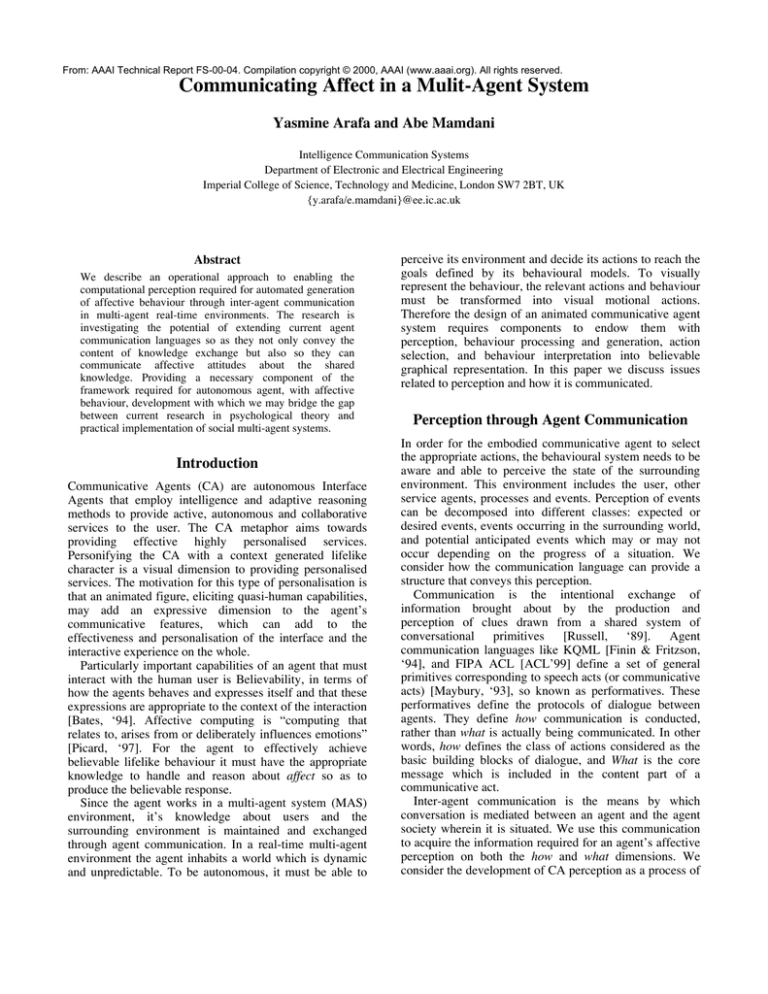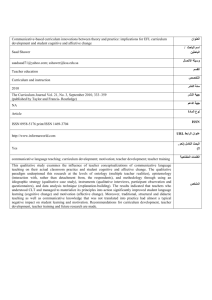
From: AAAI Technical Report FS-00-04. Compilation copyright © 2000, AAAI (www.aaai.org). All rights reserved.
Communicating Affect in a Mulit-Agent System
Yasmine Arafa and Abe Mamdani
Intelligence Communication Systems
Department of Electronic and Electrical Engineering
Imperial College of Science, Technology and Medicine, London SW7 2BT, UK
{y.arafa/e.mamdani}@ee.ic.ac.uk
Abstract
We describe an operational approach to enabling the
computational perception required for automated generation
of affective behaviour through inter-agent communication
in multi-agent real-time environments. The research is
investigating the potential of extending current agent
communication languages so as they not only convey the
content of knowledge exchange but also so they can
communicate affective attitudes about the shared
knowledge. Providing a necessary component of the
framework required for autonomous agent, with affective
behaviour, development with which we may bridge the gap
between current research in psychological theory and
practical implementation of social multi-agent systems.
Introduction
Communicative Agents (CA) are autonomous Interface
Agents that employ intelligence and adaptive reasoning
methods to provide active, autonomous and collaborative
services to the user. The CA metaphor aims towards
providing effective highly personalised services.
Personifying the CA with a context generated lifelike
character is a visual dimension to providing personalised
services. The motivation for this type of personalisation is
that an animated figure, eliciting quasi-human capabilities,
may add an expressive dimension to the agent’s
communicative features, which can add to the
effectiveness and personalisation of the interface and the
interactive experience on the whole.
Particularly important capabilities of an agent that must
interact with the human user is Believability, in terms of
how the agents behaves and expresses itself and that these
expressions are appropriate to the context of the interaction
[Bates, ‘94]. Affective computing is “computing that
relates to, arises from or deliberately influences emotions”
[Picard, ‘97]. For the agent to effectively achieve
believable lifelike behaviour it must have the appropriate
knowledge to handle and reason about affect so as to
produce the believable response.
Since the agent works in a multi-agent system (MAS)
environment, it’s knowledge about users and the
surrounding environment is maintained and exchanged
through agent communication. In a real-time multi-agent
environment the agent inhabits a world which is dynamic
and unpredictable. To be autonomous, it must be able to
perceive its environment and decide its actions to reach the
goals defined by its behavioural models. To visually
represent the behaviour, the relevant actions and behaviour
must be transformed into visual motional actions.
Therefore the design of an animated communicative agent
system requires components to endow them with
perception, behaviour processing and generation, action
selection, and behaviour interpretation into believable
graphical representation. In this paper we discuss issues
related to perception and how it is communicated.
Perception through Agent Communication
In order for the embodied communicative agent to select
the appropriate actions, the behavioural system needs to be
aware and able to perceive the state of the surrounding
environment. This environment includes the user, other
service agents, processes and events. Perception of events
can be decomposed into different classes: expected or
desired events, events occurring in the surrounding world,
and potential anticipated events which may or may not
occur depending on the progress of a situation. We
consider how the communication language can provide a
structure that conveys this perception.
Communication is the intentional exchange of
information brought about by the production and
perception of clues drawn from a shared system of
conversational primitives
[Russell,
‘89].
Agent
communication languages like KQML [Finin & Fritzson,
‘94], and FIPA ACL [ACL’99] define a set of general
primitives corresponding to speech acts (or communicative
acts) [Maybury, ‘93], so known as performatives. These
performatives define the protocols of dialogue between
agents. They define how communication is conducted,
rather than what is actually being communicated. In other
words, how defines the class of actions considered as the
basic building blocks of dialogue, and What is the core
message which is included in the content part of a
communicative act.
Inter-agent communication is the means by which
conversation is mediated between an agent and the agent
society wherein it is situated. We use this communication
to acquire the information required for an agent’s affective
perception on both the how and what dimensions. We
consider the development of CA perception as a process of
two well-defined, separate stages:
• inter-agent interaction between the various entities
within a MAS society. We further consider three
levels of inter-agent communication at which affect
may be conveyed:
• content level: referring to the actual raw message
or object intended to be communicated among the
entities;
• intentional level: expressing the intentions of
agents’ communicative acts, usually as
performatives of an agent communication
language; and
• conversational level: protocols that govern the
conversations shared between agents when
exchanging dialogue,
• CA affect model: dealing with the agents’ inner
behaviour (knowledge representation, reasoning,
learning, etc.), the agents social and affective
behaviour, and the generation of appropriate
behaviour states that are transformed into scripts for
visual embodiment in the interface.
Accordingly we make the distinction between the affect
indicators that may be conveyed at the intentional level,
which expresses semantics of communicative act
performatives, and at the content level, which expresses
facts about the domain. Such layering facilitates the
successful integration of the language to applications while
providing a conceptual framework for its understanding.
Although current primitives could be extended to
distinctively convey an affective message, the existing
primitives capture many of our intuitions about what
constitutes affect from the communicative act irrespective
of application. We consider that semantic description
provide a model of affect that is useful for modelling the
overall behaviour.
about communication intention, attitude and/or emotions.
The meaning of a communicative act is further considered
through two dimensions of interpretation [Russell, ‘89]:
Pragmatic Interpretation as the general objective expected
in terms of a physical action, and Semantic Interpretation
as propositional content. To illustrate, we take an example
of a statement like: ”Search for item X” made by agent As
to agent Ar. The Pragmatic Interpretation is the type of
action or expected goal task that As expects from Ar with
regard to the prepositional content “item X”, where in our
case here is the goal that Ar performs service search.
Whereas, the Semantic Interpretation in terms of
propositional content describes what sender As is
pertaining, where in our case is the addressee Ar and item
X.
We must further narrow the semantic interpretation to
induce some affect. For example: the agree primitive
infers a behaviour of positive nature since both parties are
agreeing. Similarly, the refuse primitive infers a behaviour
of negative nature since something is being rejected.
However, in real-time agent conversation communicative
acts are not standalone and can not alone determine
behavioural inferences because they are uttered within
particular context. What may have a positive impact on
one individual may have neutral or yet negative impact on
another. Moreover, a primitive like inform does not
convey any affect. Nevertheless, these interpretations serve
as the innate knowledge an agent may start with which can
be further focused to the context at hand through the
communicative act content. We use the propositional
content to provide a more context sensitive interpretation.
In our system we present information that specifies context
by using meta-data description of a content object using
the Content Object Description Language.
Content Language
Agent Communicative Acts
We use the performatives of agent communication
language in terms of their communicative functions rather
than being just a communication medium, and we provide
a representation of the meaning in terms of how they can
be used for affect modelling. This representation forms the
base upon which we define a set of inference rules
describing the affect process ongoing in agent
conversation, and also has implications on how a receiver
agent will interpret a conveyed message. These rules take
into account the conversation instigator’s conception of the
context at hand, including the experience, type and degree
of relation between both communicants and a model of the
receiver 's personality.
We consider affect in agent communication at the
Intentional level to define the intentional meaning behind a
performative coded as a set of goals and beliefs that sender
agent As has about receiver agent Ar, when in conversation.
This intentional meaning is represented in terms of
propositions or affect descriptors that are declarative
representations of semantic primitives conveying cues
The content language described provides the specific more
context-oriented information. We use meta-level
representation to convey more specific semantics of the
data being exchanged. For the implemented components to
be fully converged and effective in a real-time MAS, the
agents must have some knowledge about the surrounding
environment which includes affective knowledge about
internal and external states. The agents must have a
semantic and contextual understanding of the information
being exchanged. This requires a theoretical framework for
representing knowledge and belief of agents interacting
within an agent society. This includes frameworks for
representing uncertain knowledge about the surrounding
environment evolving with experience and time, awareness
of the implication of time constraints, and context-based
behaviour. For this purpose we use the notion of metalevel knowledge representation objects which are
annotations of data [McGuigan et al., ‘98], being
manipulated between the agents in a MAS. This provides
an understanding of the content being handled and hence
provides better awareness of the environment.
The abstractions hold physical and conceptual meaning
as well as affective states. Offering a structured way of coordinating content and domain data for agents without the
agents having to understand the raw content; as well as an
automated process for returning information, and feedback
regarding the state of the environment to agents in a
language the agents can understand.
By including meta-representation of the data in the
content part of the communication act, we provide an
added dimension to agent comprehension of the actual
meaning within the content exchanged. The content
objects not only serve as data that agents manipulate but
also serve as a basis for defining a social framework. Since
any information can contain vast amounts of embedded
knowledge, content object descriptions can therefore have
potential to convey associated and inferred perception.
Adding social attributes that can collectively serve as
choices that influence agents’ perception about the
underlying semantics of the content and attributes to it’s
behavioural and personality traits, provides an
improvisational basis that serves as a key aspect in
determining a CA’s character [Arafa & Mamdani, ‘99].
Content object meta-descriptions essentially ground five
important aspects of information-sharing between agents
and entities [McGuigan et al., ‘98]. The aspects defined to
allow the sharing of content across a distributed system
and facilitate scalable service provision are as follows:
• Object Description, providing an annotated view of
raw data;
• Visual Description, aiding a presentation service in
describing the temporal and spatial relationships
among different content objects for renderable objects;
• Content Semantics, giving a semantic view of the
stored objects;
• Service Descriptions, instantiated to an application
domain;
• Initial Affect Indicators that a content object will
convey in a non-context sensitive environment. These
may change drastically according to the past and
immediate states of the agent within an MAS and the
state of the environment.
The affect model includes indicators to emotions
expected when a defined content object is being handled in
a normal or non-context sensitive way. These indicators
are associated, using a set of selection rules, with a
predefined intended behaviour. This planned behaviour is
then modified to incorporate context-sensitive variables to
select the appropriate affect-based behaviour. The resulting
behaviour is then mapped to a visual (animated)
representation. Variations of animated expression
(intonation) can be realised by altering and adjusting the
intensity of the behaviour according to the immediate
situation.
Acknowledgements
The research is supported by a grant from the European
Commission ESPRIT projects funding, under grant
number EP28831.
Conclusion
The paper discusses work in progress for enabling,
building and evaluating CAs with affective behaviour in a
real-time multi-agent environment. We argued the need for
an operational approach to enabling the computational
perception required for the automated generation of
affective behaviour through inter-agent communication in
multi-agent real-time environments. The research
investigates the potential of extending current agent
communication content languages so as they not only
convey the semantic content of knowledge exchange but
also they can communicate affective attitudes about the
shared knowledge, by including new communicative acts
that can explicitly communicate emotion. We introduced
the notion of meta-level knowledge representation, of
affective relations, which are annotations of objects being
manipulated between agents in a multi-agent system that
can convey the current state. The work presented
represents a promising first step towards an enabling
technology for the creation of real-time, affect-based
communicative agents.
References
Arafa, Y. and Mamdani, E. 1999. Real-time Characters
with Artificial Hearts. In Proceedings of the 5th IEEE
Conference on Systems, Man and Cybernetics, 456564, Japan: IEEE/SMC Society.
Bates, J. 1994. The Role of Emotion in Believable Agents.
Communications of the ACM 37(7), 122-125.
Finin, T. and Fritzson, R.. 1994. KQML: A Language &
Protocol for Knowledge & Information Exchange. In
Proceedings of 19th Intl. DAI Workshop, 127–136.
FIPA ACL 1999. http://www.fipa.org/spec/fipa99spec.htm
Maybury, M. 1993. Communicative acts for generating
natural language arguments. In Proceedings of the11th
Conference of AAAI, 357-364. AAAI Press.
Mc Guigan, R., Delorme, P., Grimson, J., Charlton, P.,
Arafa, Y. and Mamdani, E. 1998. The Reuse of
Multimedia Objects by Software Agents in the Kimsac
System. In Proceedings of Object Oriented
Information Systems Conference, 156-162.
Picard, R. 1997. Affective Computing. The MIT Press.
Russell, R. ed. 1989. AI A Modern Approach. AddisonWesley.





